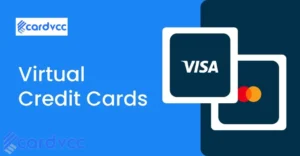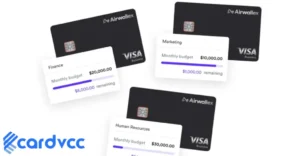Virtual business credit cards offer digital payment solutions for businesses. They enhance security and streamline expense management.

Virtual business credit cards are revolutionizing how companies handle expenses. These cards provide a digital alternative to traditional plastic cards, making transactions more secure and efficient. Businesses can generate unique card numbers for each transaction, reducing the risk of fraud.
They also allow for easier tracking and control of expenses, as each virtual card can be assigned specific limits and purposes. This helps in budgeting and financial planning. Many virtual cards integrate seamlessly with accounting software, further simplifying financial management. As businesses continue to embrace digital transformation, virtual credit cards are becoming an essential tool for modern financial operations.
Introduction To Virtual Business Credit Cards
Virtual Business Credit Cards are great for modern companies. They are digital versions of regular cards. They help businesses manage expenses easily. Learn why they are useful.
What Are Virtual Credit Cards?
Virtual credit cards are digital cards. They have no physical form. They work like regular credit cards. You get a unique card number, expiration date, and CVV. Use them online or over the phone.
Why Businesses Use Them
Businesses use virtual credit cards for many reasons. Here are some key benefits:
- Security: They reduce the risk of fraud.
- Control: Set spending limits easily.
- Convenience: Create cards quickly for different needs.
Key Features
| Feature | Description |
|---|---|
| Real-Time Tracking | Monitor expenses instantly. |
| Custom Limits | Set specific limits for each card. |
| Easy Integration | Integrate with accounting software. |
Benefits Of Virtual Business Credit Cards
Virtual business credit cards offer numerous advantages for companies. They help streamline operations and enhance security. This section explores key benefits, focusing on enhanced security and expense management.
Enhanced Security
Virtual business credit cards provide increased security for transactions. Unlike physical cards, virtual cards generate unique numbers for each transaction. This reduces the risk of fraud.
With virtual cards, companies can set spending limits and expiration dates for each card. This feature helps prevent unauthorized use. Additionally, virtual cards can be easily deactivated if compromised.
| Feature | Benefit |
|---|---|
| Unique Numbers | Reduces fraud risk |
| Spending Limits | Prevents unauthorized use |
| Expiration Dates | Enhances security |
| Easy Deactivation | Quick response to compromise |
Expense Management
Virtual business credit cards simplify expense management. They offer detailed transaction records, making it easier to track spending. This helps businesses monitor budgets effectively.
Companies can issue multiple virtual cards to different employees or departments. Each card can have specific spending rules. This improves oversight and reduces the chance of errors.
Virtual cards also integrate with accounting software. This streamlines the reconciliation process, saving time and effort. It ensures accurate financial reporting.
- Detailed transaction records for better tracking
- Multiple cards with specific spending rules
- Accounting software integration for easy reconciliation
How Virtual Credit Cards Work
Understanding how virtual business credit cards work is crucial for modern businesses. These cards offer convenience, control, and enhanced security for online transactions.
Issuing Process
The issuing process for virtual credit cards is straightforward. Businesses request a virtual card through their bank or financial institution. The bank generates a unique card number for each transaction. This number is linked to the business’s main credit card account.
The virtual card typically has a set limit. This limit can be adjusted by the business. The card also has an expiration date for added security. The issuing bank provides the card details via a secure online portal.
Businesses can issue multiple virtual cards. Each card can have its own limit and expiration date. This ensures better control over spending.
Usage Guidelines
Virtual credit cards are used for online purchases. They can also be used for recurring payments. These cards are not physical; they exist only in digital form.
To use a virtual card, enter the card details at checkout. These details include the card number, expiration date, and CVV. This process is similar to using a physical card.
Virtual cards offer enhanced security. They reduce the risk of fraud. If a virtual card number is compromised, it can be easily canceled without affecting the main account.
Businesses should monitor the usage of each virtual card. Regularly review transactions to ensure all charges are authorized. This helps in maintaining control over business expenses.
| Feature | Physical Card | Virtual Card |
|---|---|---|
| Form | Physical | Digital |
| Security | Standard | Enhanced |
| Issuing Time | Days | Minutes |
| Control | Limited | High |
Choosing The Right Provider
Picking the right virtual business credit card provider is crucial. Your choice will affect your business operations. This guide will help you understand key features and compare top providers.
Key Features To Look For
- Security: Ensure the provider offers top-tier security measures. Look for features like encryption and tokenization.
- Control: Good providers offer detailed control over spending. You can set limits and track expenses in real time.
- Integration: Check if the card integrates with your accounting software. This will save you time and reduce errors.
- Rewards: Some cards offer rewards or cashback. This can benefit your business financially.
- Support: Reliable customer support is essential. Ensure the provider offers 24/7 support.
Comparing Top Providers
| Provider | Security | Control | Integration | Rewards | Support |
|---|---|---|---|---|---|
| Provider A | High | Excellent | Yes | 5% Cashback | 24/7 |
| Provider B | Medium | Good | No | 3% Cashback | 24/7 |
| Provider C | High | Excellent | Yes | Travel Rewards | Business Hours |
Choosing the right provider involves careful consideration. Evaluate their key features and compare them. This will help ensure you pick the best option for your business.
Integrating Virtual Cards Into Your Business
Integrating virtual cards into your business can streamline operations. They offer enhanced security and better expense management. Virtual business credit cards are digital-only and can be used for online transactions.
Setting Up Accounts
Setting up virtual card accounts is simple. First, choose a provider that meets your business needs. Many banks and fintech companies offer virtual cards. Compare their fees and features.
Next, apply for the virtual card online. Fill out the application form with your business details. Once approved, you’ll receive your virtual card details. These include the card number, expiration date, and CVV code.
Store these details securely. Use a password manager to keep them safe. You can also set spending limits on each virtual card. This helps control expenses and prevents overspending.
Training Employees
Training employees to use virtual cards is essential. Start with a training session for your team. Explain the benefits of virtual cards. Show them how to use the card details for online purchases.
Provide a step-by-step guide. This can include:
- How to access virtual card details
- How to make online purchases
- How to report lost or stolen cards
Employees should know the importance of security. Teach them to avoid sharing card details. Warn them about phishing scams and suspicious emails.
Regularly update your team on any changes. Keep them informed about new features and security practices.
Integrating virtual cards into your business can be seamless. With proper setup and training, your team will benefit from this modern payment solution.

Managing Virtual Card Expenses
Managing virtual card expenses is crucial for businesses. It ensures financial control and transparency. Virtual business credit cards simplify expense management. They provide tools for real-time tracking and automated reporting.
Real-time Tracking
Real-time tracking helps monitor expenses instantly. You can see transactions as they happen. This avoids overspending and unexpected charges. Real-time updates keep your budget on track.
With real-time tracking, you get instant alerts. These alerts notify you of every transaction. This helps detect any unauthorized charges quickly. You stay informed and secure.
| Benefit | Description |
|---|---|
| Instant Updates | See every transaction as it happens |
| Immediate Alerts | Get notified for every expense |
| Better Budget Control | Avoid overspending with real-time data |
Automated Reporting
Automated reporting saves time and reduces errors. Reports are generated without manual effort. This feature is essential for busy businesses.
With automated reporting, you get detailed expense insights. It helps in making informed financial decisions. Reports can be customized to fit your needs.
- Time-Saving: Reports are generated automatically.
- Error Reduction: Minimizes human mistakes.
- Detailed Insights: Provides a deep understanding of expenses.
Automated reporting also aids in compliance. It ensures that all expenses are recorded accurately. This is important for audits and financial reviews.
Case Studies And Success Stories
Virtual Business Credit Cards are transforming financial management. They offer ease, security, and control. Businesses of all sizes benefit from these features. Let’s explore some real-life success stories.
Small Business Use Cases
Small businesses often face cash flow issues. Virtual Business Credit Cards help streamline expenses. One such example is a local bakery.
The bakery owner issued virtual cards to staff. Each card had a spending limit. This controlled expenses and reduced fraud risks.
- Increased financial control
- Reduced fraud risk
- Streamlined expense management
Another small business, a freelance graphic design firm, saw benefits. The firm used virtual cards for software subscriptions and client lunches.
| Benefits | Details |
|---|---|
| Expense Tracking | Real-time updates on card usage |
| Budget Control | Set spending limits per card |
| Time-Saving | Automated expense reports |
Enterprise-level Implementations
Larger enterprises have also adopted virtual cards. A multinational tech company implemented virtual cards for travel expenses.
Employees received virtual cards for business trips. This eliminated the need for reimbursement processes.
- Improved employee satisfaction
- Faster expense approvals
- Enhanced security for corporate funds
Another case involves an online retailer. They used virtual cards for vendor payments. This streamlined the supply chain and improved vendor relationships.
Both small and large businesses see the value of virtual cards. They offer control, security, and efficiency. These success stories highlight the growing trend.
Future Trends In Virtual Business Credit Cards
Virtual business credit cards are evolving rapidly. Let’s explore the future trends shaping this exciting financial tool. Expect advancements in technology, regulatory changes, and more.
Technological Advances
Technology will drive the future of virtual business credit cards. With AI and machine learning, fraud detection will improve. Expect faster transactions and better security.
Blockchain technology will enhance transparency and traceability. Companies will trust virtual cards more with this secure ledger system. Mobile integration will also become seamless.
Below is a table showcasing key technological advances:
| Technological Advance | Benefits |
|---|---|
| AI & Machine Learning | Improved fraud detection and faster transactions |
| Blockchain | Enhanced transparency and security |
| Mobile Integration | Seamless usage on smartphones |
Regulatory Changes
Regulations will shape the future of virtual business credit cards. Governments will enforce stricter compliance standards. These changes will protect consumers and businesses alike.
Regulatory bodies will introduce new frameworks for digital payments. These frameworks will ensure secure and fair transactions. Enhanced data protection laws will also be pivotal.
Consider these key regulatory changes:
- Stricter compliance standards
- New frameworks for digital payments
- Enhanced data protection laws
Businesses must stay updated on these regulatory changes. Compliance will be crucial for seamless operations.
Common Challenges And Solutions
Virtual business credit cards offer many benefits. They streamline expenses and boost security. But they also come with challenges. Here are common issues and solutions.
Fraud Prevention
Fraud is a big concern for virtual business credit cards. Cybercriminals can steal card details and misuse them. To prevent fraud, use strong passwords and two-factor authentication (2FA).
Monitoring transactions is also key. Regularly check your account for unusual activity. Set up alerts for large or foreign transactions. This keeps you informed and ready to act quickly.
Another solution is to issue unique virtual cards for each vendor. This limits the risk if one card is compromised. It also makes tracking expenses easier.
Integration Issues
Integrating virtual credit cards with accounting software can be tricky. Compatibility problems often arise. To solve this, choose software that supports virtual cards.
Many popular accounting tools now offer seamless integration. Check the software’s documentation for integration guidelines. If needed, contact customer support for help.
Another option is to use third-party services. These can bridge the gap between your virtual card and accounting software. They often offer additional features like expense tracking and reporting.
| Challenge | Solution |
|---|---|
| Fraud Prevention | Choose compatible accounting software and check software documentation for guidelines for third-party services for better integration |
| Integration Issues | Choose compatible accounting software and check software documentation for guidelines and third-party services for better integration |

Frequently Asked Questions
What Is A Virtual Business Credit Card?
A virtual business credit card is a digital version of a physical card. It is used for online transactions. It offers enhanced security and convenience.
How Do Virtual Business Credit Cards Work?
Virtual business credit cards generate a unique card number for each transaction. They link to your main business account. This helps in tracking expenses and preventing fraud.
Are Virtual Business Credit Cards Secure?
Yes, they are very secure. Each transaction uses a unique card number. This reduces the risk of fraud and unauthorized charges.
Can Virtual Business Credit Cards Be Used Internationally?
Yes, they can be used internationally. Ensure your card issuer supports international transactions. Check for any foreign transaction fees.
Conclusion
Virtual business credit cards offer flexibility and security for modern enterprises. They simplify expense management and protect against fraud. By integrating these cards, businesses can streamline operations and boost financial efficiency. Consider adopting virtual credit cards to enhance your company’s financial strategy and stay ahead in the competitive market.







